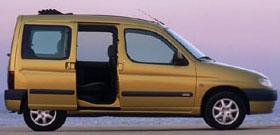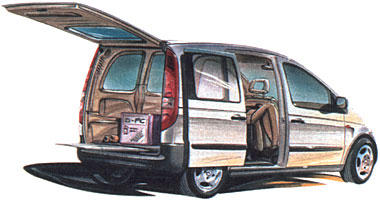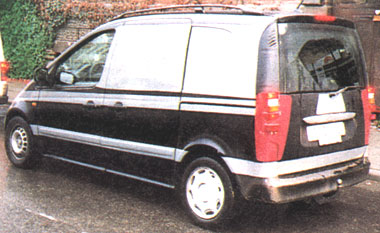
Please note that the above graphics shows how the car magazine thinks the car will look like and doesn't show an actual photographed car
Articles from "Auto
Bild", "Auto Motor und Sport", "Auto
Bild", "Auto/Strassenverkehr", "Auto
Bild"
and DaimlerChrysler
Press Text
 |
| Computer graphics and text: Auto
Bild Background retouching and further preparation
for the web by MBEP
webmaster
Please note that the above graphics shows how the car magazine thinks the car will look like and doesn't show an actual photographed car |
Translation of an article from German car mag
"Auto Bild" from Oct. 1999 written
by Michael Specht
Here comes Anton
To leave the field easily to the
others Mercedes-chief Juergen Hubbert after all does not want to. Just
to reach the promised 1 million (sale of passenger cars per year) it counts
to occupy every niche in the market.
That was the case in 1997 with
the A-Class, so it will be at the end of 2001 with the compact-van "Anton"
(working name up to now). Because Citroen/Peugeot and Renault prove: Models
like Berlingo/Partner as well as the Kangoo are the ideal "light commercial
vehicles" - and successful. For the family with two children plus a dog
as well as for workmen, taxi drivers and delivery men. Not to forget: Young
people who need space for their hobbies (wind surfing, mountain biking,
bike riding).
 |
In the meantime slightly disguised
prototypes pass through the hard daily test routines. The complete drivetrain
with sandwich-floor derives from the Mercedes A-Class
Photo and photo text left: Auto Bild
|
| Citroen Berlingo Photo: PSA/Citroen | Renault Kangoo Photo: Renault |
 |
 |
 |
| Photo and photo text: Auto Bild |
In terms of buying price "Anton"
drifts away far from Berlingo and Kangoo. Mercedes is sure that also from
DM 35.000 on ((USD 17.500 assumed USD 1 = DM 2.00)) enough customers will
get aboard. Because it is known that the craft has a golden basis.
Michael Specht
End of article from "Auto
Bild" - translation by MBEP
webmaster
As usual remarks in ((blabla)),
but (blabla) belongs to original text.
Translation of an article from German car mag "Auto Motor und Sport" from October 1999
 |
 |
| Both graphics: DaimlerChrysler | Both graphics text: Auto Motor und Sport |
With A-Class technique
Compact Van from Mercedes
Under the model designation Vaneo Mercedes at the end
of the year 2001 brings a new compact van onto the market which technically
bases on the A-Class. Though with 4.19 metres the Vaneo is easily 60 centimetres
longer than the A-Class and has a noticeably stretched wheelbase, too.
In the interior the van shall give space for five grown-ups or for two
grown-ups and three cubic metres of cargo. Access to the rear is enabled
by two standard sliding doors. As motorization the front drive vehicle
gets the A-Class units. The van developed in charge of the Mercedes commercial
department will be built in the Berlin-Ludwigsfelde plant. Per year 50.000
vehicles are planned ((to be built)).
End of article from "Auto
Motor und Sport" - translation by MBEP
webmaster.
As usual remarks in ((blabla)).
Translation of an article from German car magazine "Auto Bild" issue 49/1999 from Dec. 10th
Comes 2001: Mercedes mini-van Vaneo
 |
 |
| Both photos and photo texts: Auto Bild | Both photos: Additional preparation for the web by MBEP webmaster |
| With longer wheelbase the van grows to 4.2m | Still slightly taped the first prototypes are on test drive |
Five years. So long the Stuttgarters
enviously have to watch how the French make a mint with the practical mini
leisure-time vans a la Citroen Berlingo, Peugeot Partner and Renault Kangoo.
Only from 2001 on they can counterattack
with the Vaneo; but with DM 35.000 ((USD 17.500 assumed USD 1 = DM 2.00))
it will be DM 10.000 more costly. Technically the Vaneo is based on the
A-Class ((W168)) which means it takes over the engines (diesel and gasoline)
as well as the sandwich construction and all safety features.
End of article - translation by
MBEP
webmaster
Translation of an article from German car magazine "Auto/Strassenverkehr" issue 12 from June 1999
| Mercedes
Big A-Class . Mercedes lengthens the small one to a city delivery vehicle |
 |
 |
| Computer graphics: Auto/Strassenverkehr
Two-piece mounting and further preparation for the web by MBEP
webmaster
Please note that the above graphics shows how the car magazine thinks the car will look like and doesn't show an actual photographed car |
For the end of the year 2001 Mercedes
plans the introduction of the Compact Van. The high-roof sedan on the platform
of the A-Class after all shall serve as a manoeuvrable vehicle for delivery
purposes. Mercedes falls back on the body structure of the A-Class and
the arrangement of engine and auxiliary units in the sandwich floor remains
the same. At first the city delivery van comes with closed steel body instead
of rear windows, but a version with windows is being discussed. The entry
to the back is enhanced by rear sliding doors on the sides, the end closes
with a conventional tail gate. With a length of roughly 4.20 metres the
A-Class Van is shorter than a station wagon in the compact class, but the
removable rear seats provide a greater variability. The vehicle will be
produced in ((the city of)) Ludwigsfelde ((German federal state of)) Brandenburg
where DaimlerChrysler invests roughly DM 625 million ((USD 312.5 billion
assumed USD 1 = DM 2.00)). ((Rest of article not translated because it
is not regarding the A-Class Van)).
End of article from "Auto/Strassenverkehr"
- translation by MBEP webmaster
As usual remarks
in ((blabla)), but (blabla) belongs to original text.
DaimlerChrysler Press Text, April 14th 2000
Winter trials of the “Vaneo” compact van
 |
 |
| Both photos: DaimlerChrysler | Further preparation for the web by MBEP webmaster |
• Tuning of electronic systems such as ESP and ABS
• Numerous tests at temperatures of down to minus
35°C
• Market launch of the Mercedes-Benz compact van in
Autumn 2001
Stuttgart – while Spring is already setting in here, icy temperatures are still prevailing in north Sweden. Just the right conditions for putting a prototype through its paces. That is exactly what's happening at the moment to the Vaneo compact van, which is due to be launched on the market in autumn 2001. On the agenda is the tuning of electronic systems such as ABS, ASR (acceleration skid control) or ESP (Electronic Stability Program) under low-friction conditions – ranging from snow to sheet ice – both on the level and on hills. For this purpose, special test tracks are set up and are prepared every year with snow and ice. Some of these test tracks are on frozen lakes. In addition, the cold start characteristics as well as the heating and ventilation system are also being tested under extreme conditions.
All Mercedes-Benz basic vehicles for every model series are channelled through the "cold chamber" either in Arjeplog, Sweden or in Rovaniemi, Finland, where temperatures of minus 35°C are not unusual in the depths of winter. All of the components must stand the test in the Arctic circle. Engineers from Stuttgart-Untertürkheim test whether engine components and equipment are capable of doing what the customer expects of them, even in the worst of winters. And some of these components can only be really tested under extreme conditions. The trials specifically involved the following:
· Door seals (for icing)
· Locking systems
· Power windows/hinged quarter lights
· Deicing of all windows
· Keeping the windscreen free of (airborne) snow
· Vehicle controls (ease of movement in extreme
cold)
· Heated seats
· Windscreen, rear screen heating and exterior
mirror heating
· Screen wash system
· Dirt/ice accumulation on the vehicle as a whole
In addition to stationary testing such as the measurement of forces under the influence of cold, large distances are driven on icy and snowy roads to assess all a vehicle’s components and systems. The future Vaneo compact van passed all the tests with flying colours, including, for instance, handling trials involving extreme lane-change manoeuvres.
The future Vaneo compact van from Mercedes-Benz stands
out by virtue of its unique dimensions. At 4.19 m length, 1.74 m width
and 1.83 m height it offers enough room for five adults and two children
or for two adults and a load of up to three cubic metres. Accesss to the
rear is via either one or two sliding doors. Due to its variability the
Vaneo from Mercedes-Benz is ideal both for dual-purpose (i.e. commercial/private)
use and as a family vehicle.
End of DaimlerChrysler press text - Some minor mistakes
corrected by MBEP
webmaster
 |
 |
| Photo: Auto Bild Add. background retouching by MBEP webmaster | Photo: Auto Bild Two-piece mounting by MBEP webmaster |
| Translation of an excerpt from an article from "Auto
Bild" from 04/1999 written by Stefan Diehl.
The A-Class Shows Size ...And at the end of the year 2000 a delivery van ((will come)) ...The second step to the complete A-Class family makes the LCV in the next year. A city delivery van lengthened to roughly four metres which in a basic version aims at workmen. Trendy-chic equipped the other version shall serve parents as an alternative to ((Renault)) Kangoo and co. Platform and interior until the B-pillar are the same as with the A-Class, in the rear sliding doors are planned... End of excerpt from article - translation by MBEP webmaster As usual remarks in ((blabla)), but (blabla) belongs to original text |

|
Last revised technically: May 7th 2000...Visits
since April 24th '99. |
. |
[Sign
Guestbook]
[View Guestbook] |
![]() ..
..![]() ..
..![]() ..
..![]() ..
..![]() ..
..![]() ..
..![]() ..
..![]() ..
..![]() .
.![]()
©1999-2000 by
MBEP
webmaster![]() This is a private, non-commercial home page. For detailed disclaimer
click here
This is a private, non-commercial home page. For detailed disclaimer
click here